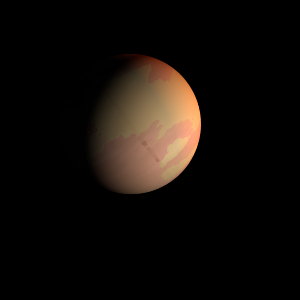|
|
Space Astro
|
Info for exoplanet "Ijitar"
| Scientific (actual) data |
|---|
| Name | TOI-4010 e |
| Planet status | Confirmed |
| Mass sini | 2.177 |
| Orbital period | 762 |
| Semi major axis | 1.57 |
| Orbit eccentricity | 0.26 |
| Discovered | 2023 |
| Updated | 2023-06-13 |
| Omega | 140 |
| K | 54.7 |
| Temperature (kelvin) | 174 |
| Publication | Published in a refereed paper |
| Detection type | Radial Velocity |
| Mass measurement type | Radial Velocity |
| Star name | TOI-4010 |
| Right ascension | 20.22° |
| Declination | 66.07° |
| Mag v | 12.3 |
| Star distance | 176.5 |
| Star metallicity | 0.315 |
| Star mass | 0.88 |
| Star radius | 0.83 |
| Star temperature | 5104 |
| Wikipedia article | TOI-4010 e |
Back
| |
| Fictional info (?) |
|---|
| Suggested name | Ijitar |
| Planet type | Cold planet |
| The planet telescopically displays the complete range of phases, similar to Venus and the Moon, as it moves in its inner orbit relative to TOI-4010, which reoccurs over the so-called synodic period approximately every 93 days.
The two polar ice caps appear to be made largely of dust.
Because of its fast rotation, the planet's shape is that of an oblate spheroid (it has a slight but noticeable bulge around the equator). |
| Atmosphere | Helium | 59% |
| Sulfur dioxide | 35% |
| Hydrogen deuteride (HD) | 4.5% |
| Molecular hydrogen | 0.79% |
| Hydrogen peroxide | 0.04% |
| Argon | 0.0073% |
| Atmospheric pressure | 0.001 bar |
 |
| No known satellites |
| Google search for Ijitar |
|
Website by Joachim Michaelis
|
|
|
|